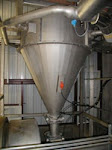The SkunK has been waiting for our real competition to begin extracting corn oil on a commercial basis so he has a decent yin graph to chart GERS' yang progress against. The true competitors have been Verasun and Primafuel. Both were going to have viable, working, commercial corn oil extraction units working in 2008? ? ? More on that later.

Sure, we also got competition in the form of mom and pops spinning their Ethanol Plant Syrups in the back enclosure off the boiler room. Best I can figure they take that result and either sell it as a livestock feed additive or mix it back into
their DDGs as a branded specialty product. I have pictures in my mind of highly paid technicians, neglecting their regular duties, processing the home made residue by skimming the corn oil off holding tanks with two x fours. The SkunK's comical visions are apparently not that far off. "Originally we allowed it to separate in our syrup tank, . ." said one process engineer using a self-designed process in
1Q 07 DGQ. Some of the independent results are described as "animal feed grade corn oil". Oh how expensive the "inexpensive route" can be. .
I have yet to find a Non-Greenshift COES producing corn oil and shipping it to a Non Greenshift Bio-diesel refinery. Once I find that I will see if any shipments are not just experiments and are done on a regular basis. [more than a one time shot might indicate it worked]. The SkunK cannot prove it is not happening, but after looking through quite a few sites and SEC filings - I cannot find it happening anywhere. Yet.
 Here is the chart real size: http://docs.google.com/Doc?id=dgzzx2hv_36kf36b3m6
Here is the chart real size: http://docs.google.com/Doc?id=dgzzx2hv_36kf36b3m6
First conclusion: Our big boy competition has not got a commercial COES up and running yet. The independents do, but in many cases it turns out animal feed quality corn oil. ICM will sell you equipment - so will crown iron works - but then where are the quality and production guarantees?
Many bio-diesel plants talk corn oil, but soon find out they cannot process it with standard equipment. GERS has 60,000 hours of commercial COES experience going to the spring of 2006 and that extracted corn oil has been made into biodiesel. Have we learned from that experience? You bet. We are almost three years down an experience trail our competitors are just beginning to walk on. The uncommitted market here is huge. The SkunK believes that virtually all Ethanol Producers will eventually extract corn oil in some fashion. The economics of the industry are pressing them to do it sooner rather than later. Greenshift could be extremely financially successful even with a competitor or two that has an operating commercial COES. Will we see the first competitor's system "this winter"? Maybe.
The SkunK has also found a newcomer to the corn oil extraction business after he built his chart above. FEC Solutions has sold only one unit that I can find. That was to LINCOLNWAY ENERGY, LLC who first ran it for six months on a trial basis starting in April 2008 . They now "expect" to produce 3000 tons of corn oil/year from their 50mmgy Ethanol plant. (This from a plant that is running about 8% over their ethanol rated capacity.) Depending how much this crude corn oil weights I figure that is between .7 and 1mmgy. That is between half to 2/3 of the results we "expect" to see from Greenshift. FEC Solutions then buys the oil for resale with a handling fee. In any case, even though we still do not have information Greenshift COES have run over a quarter at 1.5mmgy capacity, Greenshift has the big lead.
http://www.fecsolutions.com/index.htm
*********
First here is the progress of Verasun's Corn Oil Extraction Project.
"VeraSun has been eyeing the idea of corn-oil extraction since 2004"
"The company originally announced its oil extraction technology in November 2006."
"In 2007, VeraSun received a $1 million tax incentive from the state [IA] in order to develop the technology to extract corn oil from the ethanol byproduct, distillers dried grain."
"The company also received $200,000 from the state's Value Added Agricultural Products and Processes Financial Assistance Program to build a 1,300-ton-a-day corn oil extraction facility in Fort Dodge."
June 16, 2008 Verasun still said:
"The company anticipates operation of the corn-oil technology, . . . to begin in the fourth quarter of 2008."
November 2, 2008
"To date, that [corn oil extraction] facility has not been built."
*********
Here is Primafuel's Short history
Ethanol Producer Magazine
September Issue - It was expected the . . .
". . . installation of the full unit is completed in November. "
A month later . . .
Ethanol Producer Magazine
"The extraction unit is slated to be operational this winter, . . ."
BioDiesel Magazine
Jan 09 Issue. Three months later. . .
Read below carefully. Although it's not "completed". Although it's not "operational" . They did "employ" it in August 08. Man, sometimes the PR on this stuff will spin you around. Apparently "employ" is equivilent to "install". It's in place but not working.
*********
Greenshift - Abbreviated COES History
Little Sioux Corn Processors, a 50 MMgy plant in Marcus, Iowa, began using GreenShift’s technology in the spring of 2006.
Utica Energy LLC in Oshkosh, Wis., began using it in the spring of 2007.
Western New York Energy LLC in Median, N.Y., began extracting corn oil in February 2008.
******
One more thought. Greenshift's bioreactor plan is to reduce smokestack emissions of CO2 and other nefarious stuff as it produces algae for ethanol production and bio-diesel.
The best I can tell Primafuel's system and some others just plan to produce algae for fuel.
******
Good Hunting,
SkunK











 The plain arrow going to the small print just to the left of the ladder - it says "Corn Syrup Only". The feathered arrow going to the front states a capacity of 17,500 gallons. Tankers like the ones Greenshift leased may have a typical capacity from 12,000-18,000 gallons. As comparison, a large 18 wheeler truck tanker might hold 8.5K gallons.
The plain arrow going to the small print just to the left of the ladder - it says "Corn Syrup Only". The feathered arrow going to the front states a capacity of 17,500 gallons. Tankers like the ones Greenshift leased may have a typical capacity from 12,000-18,000 gallons. As comparison, a large 18 wheeler truck tanker might hold 8.5K gallons.
















